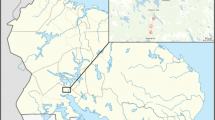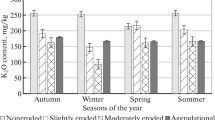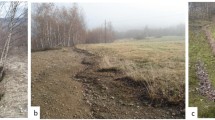Abstract
The influence of a single addition of sewage sludges to soils on the composition of fungal communities, soil pH (physical factor) and presence of Eschericha coli (sanitary factor) during 1 year was studied. Only the pH of soil treated with limed sewage sludge increased significantly from 7.01 to 7.58 after 3 months. E. coli was still present in soil 1 year after application of sewage sludge. Fungal numbers increased in the sewage-sludge-treated soil up to 6 months after application (maximum value was 7.5 times that of the control) and then decreased to reach values comparable to those of the control. Treated soils showed different fungal communities to the control with presence of keratinolytic fungi (Sporothrix schenckii, Microsporum sp.), yeasts (Geotrichum candidum, Candida sp., Rhodotorula sp. Cryptococcus sp.), and other potential pathogenic fungi (Aspergillus niger, Fusarium solani). The results indicate that fungi belonging to the genus Candida could be used as specific indicator organisms of the sanitary condition of soils treated with sewage sludge.
Similar content being viewed by others
Explore related subjects
Discover the latest articles, news and stories from top researchers in related subjects.Avoid common mistakes on your manuscript.
Introduction
Sewage sludges produced in wastewater treatment are currently applied to arable soil as alternatives to mineral fertilizers. Indeed they are a source of organic matter, macro- and microelements, having beneficial effects on the soil biota. However, different pollutants—such as salts, heavy metals, PAH or pathogenic viruses, bacteria, fungi and protozoa—may accumulate in treated soils and cause a potential risk to soil quality, productivity and finally human safety in the long term.
Doran and Parkin (1994) defined soil quality as "The capacity of soil to function within ecosystem boundaries to sustain biological productivity, maintain environmental quality, and promote plant and animal health". Micro-organisms living in soil are one of the most important factors responsible for many of the soil transformations such as decomposing organic litter or respiration. Changes in soil biological characteristics may be sensible indicators of soil quality, since they are more dynamic and even more sensitive than physical and chemical properties. The impact of sewage sludge application on soil properties such as organic matter accumulation, enzyme activity, microbial biomass or microbial activity has been widely studied (Chander and Brookes 1991; Fliessbach et al. 1994; Johansson et al. 1999; Lima et al. 1996). Soil pH is one of the most known physical indicators, which controls speeds and direction of biological processes. The presence of E. coli has been taken as an indication of fecal contamination. Scarce information is available on the effects of sewage sludge addition on the structure of fungal communities of soil.
The objective of this study was to evaluate how a 1-year application of sewage sludge to soil affected the structure of soil fungal communities, soil pH (physical factor) and survival of E. coli (sanitary factor).
Materials and methods
The soil and sewage sludge characteristics
Samples of sewage sludge were collected from four wastewater treatment plants (Poland) representing different sewage treatment technologies. The soil used in the experiment was clay loam surface- (0–20 cm) sampled from a park. Visible pieces of plant materials, stones and visible soil fauna were picked out and then the soil was sieved (<2 mm). The following physico-chemical properties for selected soil and sewage sludge were analysed: humidity by the gravimetric method, pH in H2O by the pycnometric method, total N by the Kjeldahl method, total P and total Fe by the spectrophotometric method, S and C by coulometric analysis, and Ca, Mg and K by GFAAS. Biological analyses (coliforms, Clostridium perfringens, total bacteria at 22°C and total fungi) were carried out according to Polish standards.
Experimental design
The sewage sludge and soil were mixed in plastic containers (15 dm3) at the volume ratio 1:3 (sewage sludge:soil), as recommended by the Institute of Environmental Protection (Warsaw). The following treatments were carried out: (1) controlled soil; (2) soil + lagooned (for around 12 months) sewage sludge from Częstochowa-Dźbów treatment plant; (3) soil + lagooned (for around 2 years) sewage sludge form Herby treatment plant; (4) soil + lagooned (for around 3 years) sewage sludge from Lubliniec treatment plant; (5) soil + no-limed dewatered fresh sewage sludge form Włocławek treatment plant; (6) soil + limed dewatered fresh sewage sludge from Włocławek treatment plant. Each treatment was replicated four times. The experiment started on 10 April 2001. The containers were kept under field conditions for 12 months.
Soil sampling and analysis
Samples were taken every 3 months (central month of each season of the year). The pH was measured by pycnometric method using a soil/water ratio of 1/2.5. The presence of E. coli was detected as reported by the Countryside Hygiene Institute in Lublin, Poland. Fungi were counted using the serial dilution method. Soil (10 g wet weight) was treated with 95 ml 0.1% sodium pyrophosphate and 9 ml of this suspension was transferred to tubes containing 9 ml same solution. Aliquots of the suspensions were transferred to petri dishes using pour plates with the medium described by Martin (1950). Aliquots of medium contained a mixture of penicillin and streptomycin (0.1 μg/ml) and Bengal rose (70 μg/ml). Plates were cultivated for 14 day at 25°C. Enumeration (colony forming units: CFU) and identification of isolates were carried out as reported by Gams et al. (1980).
Statistical analysis
The results presented in the tables and on the figures are arithmetic means. The significance of differences between the different combinations was tested by one-way ANOVA, using Tukey's t test. The structure and relationships among fungal communities were displayed as a dendrogram by the weighted pair-group method using arithmetic averages (WPGMA). All statistical calculations were performed using the statistical computer program STATISTICA, version 5.0.
Results
The studied sewage sludges contained a higher proportion of organic matter and plant nutrients, such as N, P and K, and higher amounts of total bacteria and fungi compared to soil. The sanitary factors, i.e. the coliforms and Clostridium perfringens, were detected in the studied sewage sludge but not in the soil (Table 1).
Generally, soil pH was not significantly changed by the treatment with sewage sludge (Table 2). Only the limed sewage sludge significantly increased the pH value (to 7.55) respective to the value of the control soil. The value was still significantly higher after 1 year.
E. coli was not detected in the control soil (Table 3), but it was isolated from all studied combinations during the experiment, with the exception of treatment 2; the bacterium was not detected at the end of incubation.
The effect of application of sewage sludge on the total number of fungi is presented in Fig. 1. After 3 months (isolation-VII 2001) the mean number of propagules increased in the studied combinations ranging from 21.4×103 CFU/g (combination 2) to 70.5×103 CFU/g (combination 3) as compared to the control (19.1×103) CFU/g, but only in two cases were the values of CFU significantly different with respect to those of the control. After 6 months in all sewage-sludge-treated soils the number of isolates was significantly higher than that of the control (10.5×103 CFU/g), ranging from 20.75×103 to 79.5×103 CFU/g. During winter, isolation totals of the colony forming units of fungi in combination 2 (13.9×103 CFU/g), 3 (17.2×103 CFU/g) and 6 (19.4×103 CFU/g) were smaller than the value of the control (19.7×103 CFU/g), but this difference was not significant. Only the value of combination 5 was significantly higher than that of the control. After 1 year of the experiment the CFU value of almost all treated soils was comparable to that (37.7×103 CFU/g) of the control. The number of propagules in combination 3 (40.2×103 CFU/g) and 5 (49.7×103 CFU/g) was higher and all other cases lower (only combination 6 showed a significant difference) than in the control.
The most common species of fungi recorded in each sample are shown in Tables 4, 5, 6, and 7. Saprophytic fungi, yeasts, keratinolytic and potential pathogenic fungi prevailed in the sewage-sludge-treated soils. Altogether 60 species were noted. In control soil different species from the genera Penicillium, Verticillium, Trichoderma, Mucor, Fusarium, Chrysosporium, Paecilomyces, and Mortierella were isolated frequently. However only in sewage-sludge-treated soils were the yeasts (belonged to the genera Geotrichum, Candida, Rhodotorula, Cryptococcus) and typical dermatophytes (Microsporum spp. or Trichophyton spp.) found.
Figures 2 and 3 show the difference between fungal communities of control and treated soils. The structures of the fungal communities of the treated soils can be separated from that of the control throughout the experimental period; mean divergences among fungal communities of treated soils were smaller (21–67% in first isolation and 15–79% in last isolation) than the divergence between control and treated soil communities (almost 100%).
Discussion
The pH of soil affects several soil properties (Paul and Clark 1998). The Polish Decree of the Minister of Environment of 1 August 2002 on the matter of municipal sewage sludges recommends monitoring pH in sewage-sludge-treated soils. We observed some changes in pH of treated soils; however this effect did not persist for long. Only in the case of limed sewage sludge application did the soil show a significantly higher pH value after 12 months. However, higher pH values of treated soils were not connected with an increase or decrease in the number of fungal populations. The similar pH value of the soil used (6.9) and sewage sludge (6.9–7.5) could probably explain the fact that in our studies the pH of soil was not affected by sewage sludge treatment.
The presence of coliform bacteria has been taken as an indication of fecal contamination in different environments, and thus of a health hazard. The survival of E. coli depends on several physical soil properties such as texture, aeration, temperature, moisture or permeation. (Cools. et al. 2001). Cools et al. (2001) showed that bacterium reached the detection limit at day 80, under optimal conditions of 5°C and 100% FC (field capacity). On the other hand, E. coli can be detected in soil in low amounts up to 250 days after manuring (unpublished data). Our investigations demonstrated that E. coli could survive well in soil over the longer period of 365 days.
The number of microscopic fungi in sewage sludge is usually very high. The number of colonies from sewage sludges in our investigations ranged from 43×103/g dry solids to 182×103/g dry solids, as has been reported previously (Stańczyk-Mazanek and Kacprzak 2001). Microscopic fungi play an essential role in the decomposition of sludge organic matter under low water content and good aeration conditions (Ulfig et al. 1996). In the present study colony-forming units of fungal populations were increased by the addition of sewage sludge confirming results obtained by Lima et al. (1996) and Pascula et al. (2000). The maximum value was observed 6 months after the application (maximum value was 7.5 times that of the control) and then colony- forming units decreased with time to values comparable with those of the control. Brendecke et al. (1993) observed that a soil treated with sewage sludge for 4 years did not show any variation in fungal counts compared to the control, and the authors concluded that there was neither inhibition nor stimulation. The short-term increase in fungal population as a function of sewage sludge addition may be explained by the presence of easily degradable organic components (proteins, lipids or carbohydrates) detected in organic residues which are necessary for fungal growth.
It is generally accepted that fungi grow better in slightly acid conditions, commonly at pH 5–7 (Cooke and Rayner 1984). The fungi occurring in acidic forest soils are tolerant of low pH (Mańka et al. 1987), despite the fact that low pH is connected with low levels of N and poor growth of the mycelium (Devêvre et al. 1996). It is known that soil fungi belonging to the genera Trichoderma (Weindling and Fawcett 1936) or Penicillium (Newsham et al. 1995) show higher activity in an acidic environment. However, soils acidified below pH 3.5 reduced or completely inhibited the growth of Aspergillus sp., Trichoderma sp., and Penicillium sp. (Bewley and Stozky 1983). Ulfig et al. (1996) paid special attention to the influence of pH on the distribution of keratinolitic fungi in sewage sludge. However in the present investigations we did not detect any correlation between soil pH and number of fungal colony units or occurrence of specific species. Kennedy and Papendick (1995) proved that micro-organisms are very sensitive indicators of changes in soil quality. According to Schnaak et al. (1997) use of sewage sludge for agricultural purposes may significantly change soil metabolism, as a consequence of damage sustained by the soil fungi. Our data confirm that sewage sludge application introduced fungal populations not present in soil. The control soil was richer in Penicillium, Verticillium, Mucor, Mortierella, Fusarium, Geotrichum and Trichoderma flora than treated soils. Soil amendment with sewage sludge increased the Trichoderma population (known as the biocontrol agent against plant diseases). The treatment of soil with fresh, limed and logooned sewage sludge caused the long-term survival of human pathogenic fungi (for example Candida, Trichophyton, Microsporon or Rhodotorula) which were still present 12 months after the soil amendment. Thus, sewage sludge may also be an important cause of soil pollution. The clinical importance of Candida is increasing (Chabasse 1994), because besides dermatophytes it has been implicated as the primary agent of mycotic lesions like onychomycosis. The level of Candida albicans is closely and significantly related to the numbers of fecal coliforms in sea water and it has been proposed as a microbiological indicator of soil quality by Mendes et al. (1998).
In conclusion, the fungal population of sewage-sludge-treated soils can be changed by the treatment and pathogenic fungi, such as Candida or Trichophyton, can live in the soil for at least 1 year. These results confirm the necessity of a careful application of sewage sludge to soil. The fungal pathogens can get into the food chain, and can also be deleterious for the environment.
References
Bewley RJF, Stozky G, (1983) Simulated acid rain (H2SO4) and microbial activity in soil. Soil Biol Biochem 15:425–429
Brendecke JW, Axelson RD, Pepper IL (1993) Soil microbial activity as an indicator of soil fertility: long-term effects of municipal sewage sludge on an arid soil. Soil Biol Biochem 25:751–758
Chabasse D (1994) Le nouveaux champignons opportunists apparus en médicine. J Mycol Méd 4:9–28
Chander K, Brookes PC (1991) Effects of heavy metals from past application of sewage sludge on microbial biomass and organic matter accumulation in a sandy loam and silty loam UK soil. Soil Biol Biochem 25:1231–1239
Cooke RC, Rayner ADM, (1984) Ecology of saprotrophic fungi. Longman, London, pp 40–41
Cools D, Merckx R, Vlassak, Verhaegen J (2001) Survival of E. coli and Enterococcus spp. derived from pig slurry in soils of different texture. Appl Soil Ecol 17:53–62
Devêvre O, Garbaye J, Botton B (1996) Release of complexing organic acids by rhizosphere fungi as a factor in Norway spruce yellowing in acidic soils. Mycol Res 100(II):1367–1374
Doran JW, Parkin TB (1994) Defining and assessing soil quality. In: Doran JW (ed) Defining soil quality for a sustainable environment. (SSSA special publication no. 35) SSSA, ASA, Madison, Wis., pp 3–23
Fliessbach A, Martens R, Reber HH (1994) Soil microbial biomass and microbial activity in soils treated with heavy contaminated sewage sludge. Soil Biol Biochem 26:1201–1205
Gams W, Anderson TH, Domsch W (1980) Compendium of soil fungi. Academic Press, London
Johansson M, Stenberg B, Torstensson L (1999) Microbiological and chemical changes in two arable soils after long-term sludge amendments. Biol Fertil Soils 30:160–167
Kennedy AC, Pependick RI (1995) Microbial characteristic of soil quality. J Soil Water Conserv 50:243–248
Lima JA, Nahas E, Gomes AC (1996) Microbial populations and activities in sewage sludge and phosphate fertilizer-amended soil. Applied Soil Ecol 4:75–82
Mańka K, Przezbórski A, Kwaśna H, Żółtańska E (1987) Effect of pH on the activity of some fungi isolated from forest and agricultural sites (in Polish). Zesz Probl Post Nauk Rol 307:175–196
Martin JP (1950) Use of acid rose bengale and streptomycin in the plate method for estimating soil fungi. Soil Sci 6:215
Mendes B, Urbano P, Alves C, Morais J, Lapa N, Oliviera JS (1998) Fungi as environmental microbiological factors. Water Sci Tech 38(12):155–162
Newsham KK, Watkinson AR, Fitter AH (1995) Rhizosphere and root infecting fungi and the design of ecological field experiments. Oecologia 102:230–237
Pascula JA, Hernandez T, Garcia C, De Leij FAAM, Lynch JM (2000) Long-term suppression of Pythium ultimum in arid soil using fresh and composed municipal wastes. Biol Fertil Soils 30:478–484
Paul EA, Clark FE (1998) Soil microbiology and biochemistry. Academic Press, New York
Schnaak W, Küchler T, Kujawa M, Henschel K-P, Süßenbach D, Donan R (1997) Organic contaminants in sewage sludge and their ecotoxicological significance in the agricultural utilization of sewage sludge. Chemosphere 35:5–11
Stańczyk-Mazanek E, Kacprzak M (2001) Analiza mikologiczna osadów z wybranych oczyszczalni ścieków. Materiały z IV konferencji naukowo-technicznej "Przyrodnicze użytkowanie osadów ściekowych" Bydgoszcz 4–6 czerwca 2001. Inz Ekol 3:109–115
Ulfig K, Terakowski M, Płaza G, Kosarewicz O (1996) Keratinolitic fungi in sewage sludge. Mycopathologia 136:41–46
Weindling R, Fawcett HS (1936) Experiments in the control of Rhizoctonia damping-off of citrus seedlings. Hilgardia 10:1-6
Acknowledgements
We wish to thank Halina Jablonska and Lucyna Gadek for their technical assistance.
Author information
Authors and Affiliations
Corresponding author
Rights and permissions
About this article
Cite this article
Kacprzak, M., Stańczyk-Mazanek, E. Changes in the structure of fungal communities of soil treated with sewage sludge. Biol Fertil Soils 38, 89–95 (2003). https://doi.org/10.1007/s00374-003-0633-2
Received:
Accepted:
Published:
Issue Date:
DOI: https://doi.org/10.1007/s00374-003-0633-2







